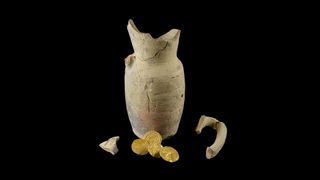Ancient gold stash found in jug in Jerusalem
The coins date back at least 1,050 years.

A thousand-year-old piggy bank has been discovered in Jerusalem.
A small jug discovered in the Israeli capital's Jewish Quarter last month turns out to contain four gold coins — the equivalent of four month's salary for a common laborer at the time the coins were tucked away more than 1,000 years ago.
Archaeologists discovered the hidden loot while surveying a site prior to the construction of an elevator to the Western Wall Plaza, a historic public square in Jerusalem's Old City. Israel Antiquities Authority (IAA) inspector Yevgenia Kapil found the juglet, a clay vessel not much bigger than a coffee cup. Weeks later, excavation director David Gellman, an IAA archaeologist, upended the juglet into his hand and was shocked when a handful of coins came out with the dirt.
"This is the first time in my career as an archaeologist that I have discovered gold, and it is tremendously exciting," Gellman said in a statement.
Related: In images: The largest stash of gold coins in Israel
The coins were exciting not simply because they were gold, but also because they made it easy to determine the age of the treasure cache. They all dated to between the years 940 and 970, according to the IAA. This era was one of major political change, when the Shiite Fatimid dynasty conquered Egypt, Syria and Israel, all which had previously been under the rule of the Sunni Abbasid dynasty.
The coins represent this transition: Two were minted in the city of Ramla in central Israel during the rule of the Sunni Caliph al-Muti' and his regional governor, Abu 'Ali al-Qasim ibn al-Ihshid Unujur (also spelled Abu'l-Qasim Unujur ibn al-Ikhshid), who was in charge between 946 and 961. The other two were minted in Cairo during the reign of the Shiite ruler al-Mu'izz (A.D. 953–975) and his successor, al-'Aziz (A.D. 975–996).
Sign up for the Live Science daily newsletter now
Get the world’s most fascinating discoveries delivered straight to your inbox.





The coins were perfectly preserved and didn't even need to be cleaned to be identified, Robert Kool, a coin expert at IAA, said in the statement. It's the first time in 50 years that a gold cache from the Fatimid period has been found in Jerusalem's Old City, he added. The money might have represented someone's entire savings, or perhaps just a fraction of a family's wealth, depending on who stashed it away.
"Four dinars was a considerable sum of money for most of the population, who lived under difficult conditions at the time," Kool said. "It was equal to the monthly salary of a minor official, or four months' salary for a common laborer."
But others would have made far more, Kool said. "A senior treasury official could earn 7,000 gold dinars a month," Kool said, "and also receive additional incomes from his rural estates amounting to hundreds of thousands of gold dinars a year."
This finding comes after the discovery of an 1,100-year-old gold coin stash in Israel this past summer and a hidden trove of 1,200-year-old gold coins in the Israeli city of Yavne in January.
Originally published on Live Science.

Stephanie Pappas is a contributing writer for Live Science, covering topics ranging from geoscience to archaeology to the human brain and behavior. She was previously a senior writer for Live Science but is now a freelancer based in Denver, Colorado, and regularly contributes to Scientific American and The Monitor, the monthly magazine of the American Psychological Association. Stephanie received a bachelor's degree in psychology from the University of South Carolina and a graduate certificate in science communication from the University of California, Santa Cruz.